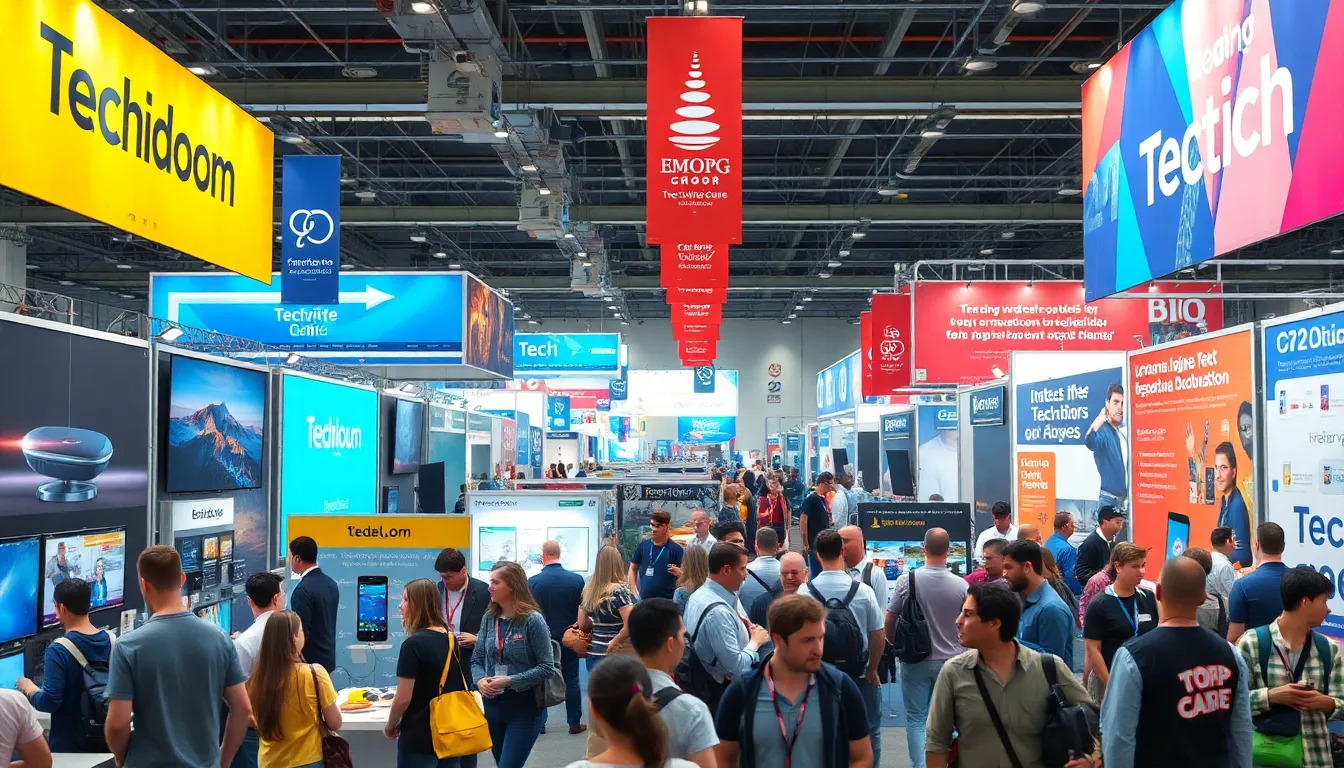Tech fairs are the playgrounds for the curious and the innovators, where gadgets and gizmos come to life. Picture a bustling arena filled with the latest in tech wizardry, from mind-blowing virtual reality experiences to robots that can probably outsmart your dog. These events are not just for the tech-savvy; they’re for anyone who’s ever wondered how a toaster could make their morning routine more exciting.
Table of Contents
ToggleOverview of Tech Fairs
Tech fairs serve as dynamic platforms that display a range of groundbreaking innovations. These events attract various audiences, from tech enthusiasts to casual observers eager to explore the latest advancements. Attendees experience cutting-edge technologies, including virtual reality displays and interactive robotics.
Innovators and startups often showcase their creations, providing a space for networking and collaboration. Participants learn about emerging trends that influence everyday life, influencing how people perceive and utilize technology.
Hands-on demonstrations remain a core feature, allowing individuals to engage directly with products and concepts. Educational sessions offer insights into industry developments, covering topics from artificial intelligence to sustainable tech solutions. These conferences often highlight the impact of technology in diverse sectors, including healthcare, education, and entertainment.
Exhibitors gain valuable exposure, promoting their products and services within an enthusiastic environment. Many tech fairs also feature competitions, encouraging creativity and innovation among participants. The atmosphere buzzes with excitement as breakthroughs in technology are unveiled.
Community involvement plays a significant role, fostering connections between innovators, investors, and consumers. By allowing open discussions and feedback, tech fairs cultivate an ecosystem that promotes growth and understanding. Overall, these events become a melting pot of ideas, pushing the boundaries of what’s possible in technology.
Types of Tech Fairs

Tech fairs come in various formats, each uniquely catering to specific interests and industries. Understanding these types helps participants find the right event that meets their needs.
Industry-Specific Fairs
Industry-specific fairs focus on particular sectors such as healthcare, finance, or education. Companies and startups showcase solutions directly relevant to their fields. Demonstrations of specialized technology foster direct interaction between exhibitors and professionals. Networking opportunities abound, allowing participants to form strategic partnerships and share insights. Educational sessions highlight challenges and innovations specific to each industry, giving attendees a deeper understanding of trends and advancements.
General Tech Expos
General tech expos encompass a broad spectrum of technological advancements across multiple industries. These events attract a wide array of exhibitors, presenting the latest gadgets and solutions. Attendees experience hands-on demonstrations that highlight a variety of topics, from artificial intelligence to consumer electronics. Keynote speakers often include industry leaders sharing valuable knowledge and insights. Exposure to diverse innovations sparks inspiration and showcases collaborations that drive the future of technology.
Benefits of Attending Tech Fairs
Attending tech fairs offers numerous advantages, making them worthwhile experiences for various participants.
Networking Opportunities
Networking thrives at tech fairs, where innovators, startups, and professionals connect. Attendees converse with industry leaders, exchanging ideas and forming partnerships. Building relationships can lead to collaborations that enhance projects, combining resources effectively. Engaging in discussions during workshops or breakout sessions provides additional chances to meet like-minded individuals. Diverse backgrounds enrich networking, facilitating knowledge sharing across multiple sectors. Those who participate often leave with valuable contacts and connections that may support career goals. In this fast-paced tech landscape, a broad network opens doors to new opportunities.
Exposure to Innovation
Exposure to innovation stands as a key benefit of tech fairs. Attendees witness cutting-edge technologies firsthand, experiencing their potential in real-time. Various companies display products ranging from artificial intelligence software to advanced robotics. Participating in demonstrations allows individuals to grasp how these innovations can solve real-world problems. Learning about emerging trends during keynote speeches enriches understanding of the tech ecosystem. Exhibitors present new solutions aimed at improving efficiency across sectors like healthcare and education. Discovering these advancements inspires creativity, encouraging attendees to think about future applications in their own fields. Tech fairs serve as a catalyst for imagination, fostering a mindset focused on growth and innovation.
Key Elements of Successful Tech Fairs
Successful tech fairs rely on specific elements that enhance attendee engagement and participation. These factors contribute to the overall experience, ensuring the event’s impact and relevance.
Location and Venue
Selecting the right location and venue matters greatly in tech fairs. Accessibility plays a crucial role, as convenient transportation links attract a larger audience. The space must accommodate exhibitors and attendees, providing enough room for demonstrations and workshops. Amenities enhance the experience; Wi-Fi access, charging stations, and breakout areas foster interaction. A vibrant environment also stimulates creativity and exploration, further enticing visitors to participate.
Program and Speakers
An engaging program with diverse speakers captivates attendees at tech fairs. Keynote speakers should represent various fields, offering unique insights into emerging trends and innovations. Workshops encourage hands-on learning, allowing participants to delve deeper into specific technologies. Schedule flexibility accommodates different interests, with some sessions focusing on industry trends while others cover practical applications. Including panel discussions fosters dialogue among experts, enriching the experience. Overall, a well-rounded program strengthens the value of tech fairs, making them essential events for learning and networking.
Future Trends in Tech Fairs
Emerging technologies play a crucial role in shaping the future of tech fairs. Virtual reality experiences are set to become standard features, allowing attendees to immerse themselves in interactive environments. Augmented reality applications will enhance product demonstrations by providing additional layers of information. Quantum computing presents another frontier, enticing innovators and startups to showcase its potential.
Sustainability is also gaining traction at tech fairs. Green technology solutions are becoming focal points as exhibitors highlight eco-friendly innovations. Electric vehicles and renewable energy sources feature prominently, addressing urgent environmental concerns. Healthtech advancements showcase telemedicine and wearable technologies, underlining the growing need for efficient healthcare solutions.
Networking opportunities at tech fairs are evolving. Online platforms facilitate connections beyond the physical boundaries of events. Attendees might leverage social media to arrange meetings, expanding their networking potential. Workshops and roundtables will encourage collaborative discussions around pressing industry challenges, fostering synergies among participants.
Inclusivity and diversity are prioritized, with a growing emphasis on highlighting underrepresented voices in technology. Panels featuring diverse perspectives aim to inspire a wider audience. Encouraging participation from different backgrounds enhances creativity and problem-solving.
The integration of artificial intelligence is transforming the overall experience. Smart matchmaking algorithms assist attendees in finding relevant exhibitors and sessions tailored to their interests. AI-driven insights will likely streamline event planning, improving logistics and attendee satisfaction.
Increasingly, gamification elements are included to engage visitors. Challenges and competitions create excitement, motivating participants to explore new technologies. Prizes for innovative ideas encourage creativity, making the fairs a hotbed for fresh concepts.
These trends collectively elevate tech fairs into multidimensional experiences. The blend of technology, networking, and collaboration fortifies their status as essential events in the ever-evolving tech landscape.
Tech fairs are more than just exhibitions; they’re vibrant hubs of innovation and collaboration. By bringing together diverse participants from various sectors, these events create an environment ripe for networking and idea exchange. Attendees walk away not only inspired by the latest technologies but also equipped with new connections that can propel their projects forward.
As technology continues to evolve, so will the format and focus of these fairs. Emphasizing sustainability and inclusivity will ensure that they remain relevant and accessible to all. With the integration of immersive experiences and cutting-edge advancements, tech fairs are poised to shape the future of technology and its impact on everyday life.





